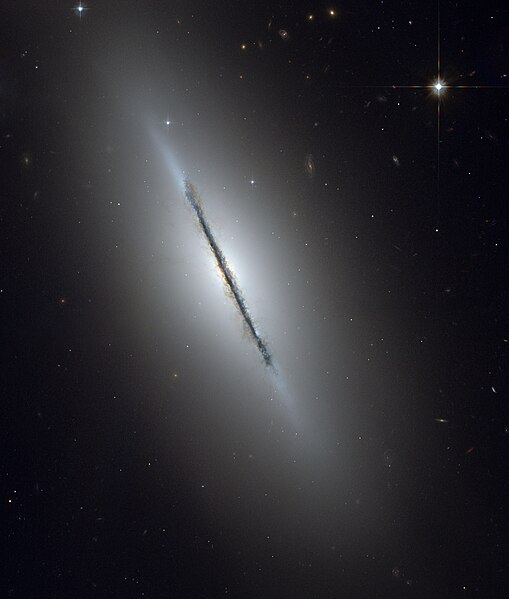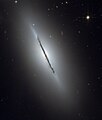קובץ:Ngc5866 hst big.jpg

גודל התצוגה המקדימה הזאת: 509 × 599 פיקסלים. רזולוציות אחרות: 204 × 240 פיקסלים | 408 × 480 פיקסלים | 652 × 768 פיקסלים | 870 × 1,024 פיקסלים | 1,739 × 2,048 פיקסלים | 3,190 × 3,756 פיקסלים.
לקובץ המקורי (3,190 × 3,756 פיקסלים, גודל הקובץ: 11.45 מ"ב, סוג MIME: image/jpeg)
היסטוריית הקובץ
ניתן ללחוץ על תאריך/שעה כדי לראות את הקובץ כפי שנראה באותו זמן.
| תאריך/שעה | תמונה ממוזערת | ממדים | משתמש | הערה | |
|---|---|---|---|---|---|
| נוכחית | 22:07, 29 ביולי 2009 |  | 3,756 × 3,190 (11.45 מ"ב) | Tryphon | Better quality, from http://imgsrc.hubblesite.org/hu/db/images/hs-2006-24-a-full_jpg.jpg. |
| 20:49, 16 בפברואר 2009 |  | 3,756 × 3,190 (879 ק"ב) | Spencer | Much higher res | |
| 01:29, 27 במרץ 2007 |  | 1,507 × 1,280 (1.38 מ"ב) | Barfoo2 | == Summary == From original NASA press release: :This is a unique view of the disk galaxy NGC 5866 tilted nearly edge-on to our line-of-sight. Hubble's sharp vision reveals a crisp dust lane dividing the galaxy into two hal |
שימוש בקובץ
הדפים הבאים משתמשים בקובץ הזה:
שימוש גלובלי בקובץ
אתרי הוויקי השונים הבאים משתמשים בקובץ זה:
- שימוש באתר ast.wikipedia.org
- שימוש באתר be.wikipedia.org
- שימוש באתר ca.wikipedia.org
- שימוש באתר cs.wikipedia.org
- שימוש באתר de.wikipedia.org
- שימוש באתר el.wikipedia.org
- שימוש באתר en.wikipedia.org
- שימוש באתר en.wikibooks.org
- שימוש באתר eo.wikipedia.org
- שימוש באתר es.wikipedia.org
- שימוש באתר eu.wikipedia.org
- שימוש באתר fi.wikipedia.org
- שימוש באתר fr.wikipedia.org
- Dragon (constellation)
- Galaxie
- Utilisateur:Itzcoalt
- Modèle:Utilisateur mystère
- Catégorie:Utilisateur Mystère
- Utilisateur:Patrinet/Galerie Utilisateur
- Utilisateur:Corle1nes
- Utilisateur:Célestin Moreau/Galaxies
- Utilisateur:Nicolas ANCEAU/Bibliothèque
- Utilisateur:Caro L
- Utilisateur:Viatcheslav
- Utilisateur:Silassouille
- Utilisateur:Chappa'ai7
- Utilisatrice:Ecureuil 1234
- Utilisatrice:MamzellTopi
- שימוש באתר hr.wikipedia.org
- שימוש באתר hu.wikipedia.org
- שימוש באתר hy.wikipedia.org
- שימוש באתר id.wikipedia.org
- שימוש באתר it.wikipedia.org
- שימוש באתר ja.wikipedia.org
- שימוש באתר kk.wikipedia.org
- שימוש באתר ko.wikipedia.org
